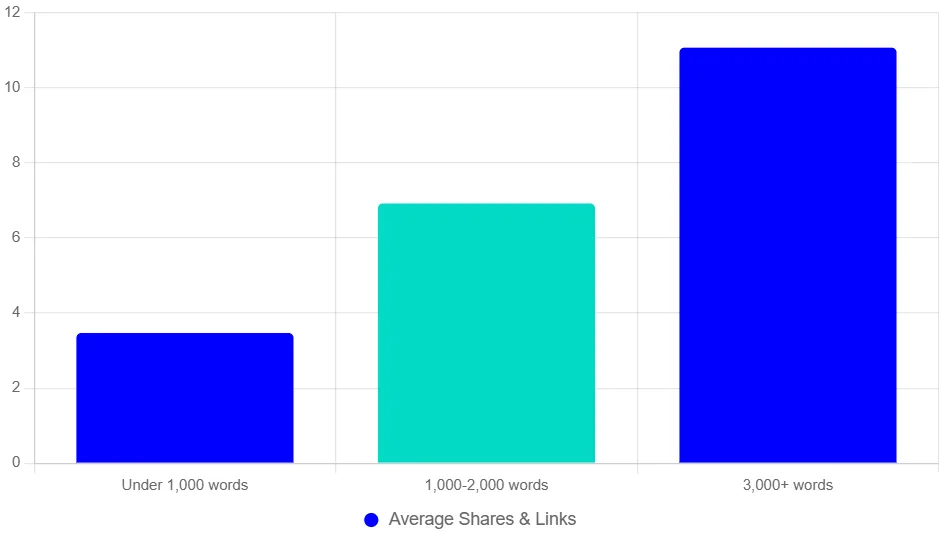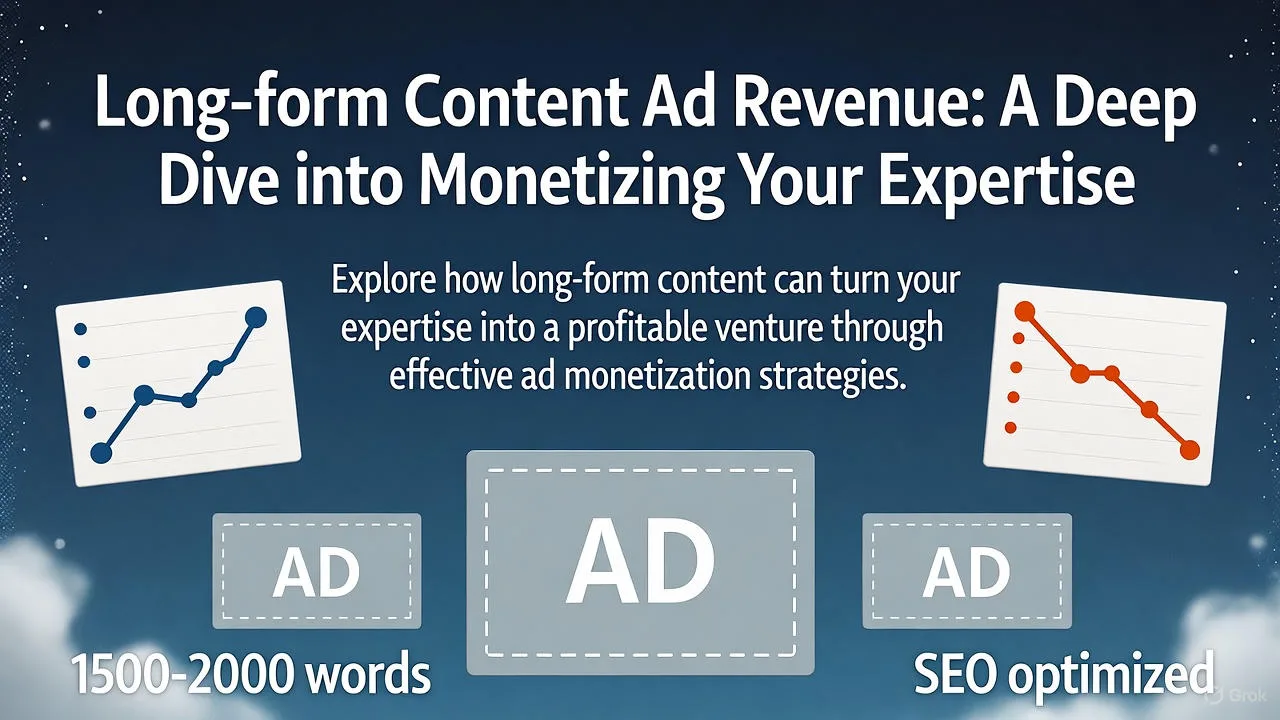Imagine you’re building a cool website full of blog posts. But your ad money feels tiny. Ouch, right? That’s a big pain for many starters. Short posts might seem easy. Yet they skip big wins. Long-form content ad revenue changes that game. It pulls in more cash from ads like Google AdSense.
So, what’s the deal? Stick with me. We’ll unpack why longer posts rock for your wallet. You’ll get simple steps too.
What Is Long-Form Content?
Long-form content means deep dives into a topic. Think of it like a full adventure story, not a quick comic strip. It runs over 1,500 words. Often hits 2,000 or more.
This style packs facts, tips, and stories. It builds trust fast. Readers stay longer. That’s gold for sites chasing AdSense nods.
Google digs it too. It shows you’re an expert. Like a teacher with a thick textbook.
How Long Should a Blog Post Be?
Short answer: Aim for 1,500 to 2,400 words. That’s the sweet spot for most blogs. Why? Top Google spots love that range.
Think of it this way. A quick note is fun but forgets fast. A long guide sticks like glue. Studies show posts around 1,890 words rank high.
But don’t just count words. Make every one count. Quality beats length every time.
“The average content length of the top 10 search results in Google is ~2,200 words.” – Backlinko, via SEO.co
Why Long-Form Content Boosts Ad Revenue
Here’s the big why. Long posts keep eyes glued. More time on page equals more ad views. Boom – higher revenue.
Short stuff? Readers bounce quick. Ads barely flash. Long-form flips that. It hooks with stories and tips.
Proof time. Longer content grabs 3x more shares and links. That boosts traffic. More visitors, more clicks.
Check this chart. It shows average shares by word count. See how it climbs?

This ties to E-E-A-T. Your deep posts scream expertise. Google trusts you more. AdSense approves faster.
On monetization impact? Creators see 35% live off ads. Long-form amps that up. Expect 20-50% revenue jumps with steady traffic.
“Ultimately, you should create long-form content because it will get you more of what you want: more online visibility (social shares, links), more proof of your expertise, and more conversions.” – Neil Patel
Long-Form Content SEO Secrets
SEO is your site’s map to more eyes. Long-form content SEO shines here. Why? It matches what searchers crave – full answers.
Google’s algorithm favors depth. Short posts rank quick but fade. Long ones build authority. They snag backlinks like magnets.
Relate to user experience? Readers love no-fluff guides. They share and return. That’s SEO rocket fuel.
Pro tip: Weave in related keywords naturally. Like “how long should a blog post be” in a heading. Boom – better ranks.
Best Content for Monetization
Content for monetization needs smarts. Pick evergreen topics. Like “best tools for kids coding.” Timeless wins.
Why matters? Ads pay on clicks and views. Helpful stuff pulls both. Tie to pain points. Solve “why my site earns zilch?”
Impact on strategy? Mix formats. Add images, lists. Keeps it fresh.
Experts agree. Deep content converts browsers to buyers. Or ad-clickers.
“Content marketing is the strongest and hardest possible soft sell. Real-world examples have power and add legitimacy to your message.” – Michelle Yin
From Google: They hunt unique long-form for AdSense sites. Thin stuff? Rejected.
“AdSense look for established authority sites, with truly new and unique longform text content, that rank well in search.” – Google AdSense Community Expert
Smart Ways to Place In-Content Ads
In-content ads blend right in. Place them mid-post. After a key tip. Readers scroll past naturally.
Think game rules. Ads are side quests. Don’t block the main path.
Here’s HTML code to add one. Simple div for AdSense.
<div style="text-align: center; margin: 20px 0;">
<script async src="https://pagead2.googlesyndication.com/pagead/js/adsbygoogle.js?client=ca-pub-YOUR-ID"
crossorigin="anonymous"></script>
<!-- In-Content Ad -->
<ins class="adsbygoogle"
style="display:block"
data-ad-client="ca-pub-YOUR-ID"
data-ad-slot="YOUR-SLOT"
data-ad-format="auto"
data-full-width-responsive="true"></ins>
<script>
(adsbygoogle = window.adsbygoogle || []).push({});
</script>
</div>
Swap YOUR-ID with yours. Test spots. Aim for 3-5 per long post.
This boosts views without annoyance. Win-win.
Short vs. Long-Form Content: A Quick Comparison
| Content Type | Word Count | SEO Benefit | Engagement Level | Monetization Potential | Cons |
|---|---|---|---|---|---|
| Short-Form | 300-1,000 | Quick top-5 ranks | Fast reads, high bounce | Low ad views, quick cash | Less authority, fewer links |
| Long-Form | 1,500-2,500 | Top-10 spots, backlinks | Deep dives, more shares | High revenue from time on site | Takes longer to write |
This table helps you pick. Go long for big bucks.
How to Create Killer Long-Form Posts: Your Checklist
- Pick a hot topic. Solve a real itch, like “easy AdSense tips for newbies.”
- Outline first. Bullet main points. Add stories or analogies.
- Write deep. Hit 2,000 words. Use short sentences. Mix in lists.
- Add visuals. Drop images or that HTML ad code.
- Edit twice. Cut fluff. Read aloud for flow.
- Optimize SEO. Slip in “long-form content ad revenue” naturally.
- Promote it. Share on social. Watch traffic soar.
Follow this. Your posts will shine. Ad money follows.
“Content marketing is a commitment, not a campaign.” – Jon Buscall
Ready to Boost Your Ad Revenue?
So, what’s the bottom line? Long-form content ad revenue isn’t luck. It’s smart work. Dive deep. Watch your site grow.
Trends say more creators go long in 2025. With AI tools helping outlines. Jump in now.
You’ve got this, kid. Start one post today. Your future wallet thanks you.
Frequently Asked Questions (FAQs)
How long should a blog post be for max ad revenue?
Shoot for 1,500-2,400 words. It balances depth and reads. More time on page means more ads shown.
Does long-form content SEO really help AdSense approval?
Yes! Google sees your expertise. Unique, long stuff screams E-E-A-T. Rejections drop fast.
What’s the best content for monetization on a new site?
Evergreen guides. Solve pains like low traffic. Add in-content ads mid-way.
Can short posts ever beat long-form for revenue?
Sometimes for quick wins. But long crushes overall. Use both – short for hooks, long for cash.






